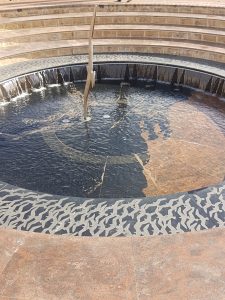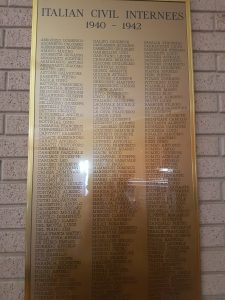World War II saw the building of numerous prisoner of war huts and control centres in and around the Wheatbelt and South West of Western Australia. Prisoners of War, predominantly from Italy and for a short period of time, Germans also, were housed in these huts on farming properties to help with the war effort. As the war progressed and more Australian men were required on the war front overseas, food shortages became evident due to reduced farm labour. To this day, there is only one hut still standing and is in fair condition can be located in the small farming town of Bruce Rock, located 255kms east of Perth in the Wheatbelt region.

Located approximately 207km (128 miles) from the west coast (Steep Point) of Western Australia at a depth of approximately 2,468 metres, the wreck of HMAS Sydney was found in 2008. It was sunk by the German raider HSK Kormoran in 1941.
The Allied authorities sent POWs from the North Africa, Greek and Crete campaigns to Australia with the first lot arriving in Sydney in August 1941. German sailors from the HSK Kormoran, the German raider which sunk the HMAS Sydney before sinking itself off the North West coast of Australia, were transported to Harvey initially before being moved to South Australia due to security issues in that the Harvey camp at the time was too close to the Australian coastline.

Italian Civil POW internees list at Harvey Internment Camp from 1940 – 1942
Military run internment camps for German, Japanese and Italian aliens were built in Harvey and with POW camps in nearby Marrinup, 4kms west of Dwellingup. The Marrinup camp was known as No. 16 Prisoner of War camp and became the administrative centre for all POW activities in Western Australia. When Mussolini declared war on the British Empire in June 1940, regardless of how long Italians in Australia had been in the country or even become citizens, they were rounded up and interned as they were seen as ‘threats to national security’. They were sent to the Harvey internment camp.
By 1943, the Italian POWs were moved to the rural areas providing farm labour and were instrumental in helping to develop new agricultural districts. The scheme was very successful and as word spread, there were not enough POWs to keep up with the requests! Eighteen months later,there were already 3500 Italian POWS in Western Australia working on the farms or special projects particularly at Jarrahdale and Northcliffe. Some either worked on the farms by day and returned at night to the camps or they were accommodated on the farms on which they worked. The farmer would pay the Army to have a POW work on the farm and in turn the money was paid to the POW.
One such Prisoner of War Hut, typical of housing that was built by the POW himself can be found on the Locke farm in Bruce Rock. Association with the farm owner and POW was frowned upon by the authorities however the consensus was that if they treated the Italian POWs as equal human beings, someone somewhere would treat the Australian POW soldier with the same dignity. The POW was welcomed into the family often eating meals together, socialising and playing with the children when time permitted. There were reciprocal interactions between the POWs and farming families ranging from exchanging recipes, language and ideologies.
The huts were usually a one room building with a verandah constructed from materials, such as asbestos sheets and iron, found around the farm or removed from outbuildings on the property.
By the middle of 1946 the POW camps and Control Centres began to close down with the Germans being repatriated to Germany via Victoria whilst the Italian POWs were sent to the Northam Army Camp. Once all the Italians were repatriated, the post war migration to Western Australia began in earnest and interestingly enough, the Northam Army Camp was once again put to use, this time a temporary home for these new migrants who docked in Fremantle.
For your next roadtrip, here are a few suggestions of where you can stop when you #WanderOutYonder.
HARVEY: Stop at the Harvey Visitor Centre and ask for a visit of the chapel at the internment camp with a guide or better still, ring them ahead of time to ensure a guide is available at the time you will be in Harvey. It is within a short casual stroll from the Visitor Centre. As the guides are volunteers to the centre, a gold coin donation at the Internment Camp is appreciated for the maintenance and upkeep. The chapel houses preserved documents from the era including lists of those who lived at the camp for a period of time.
Want to eat? Head back to the Visitor Centre and at the back is Stirling Cottage, Harvey where you can sit down and have a freshly made meal in a cafe style setting overlooking a small brook running on the side of the property. Stirling Cottage is the replica of the original cottage where the author May Gibbs of “Snugglepot and Cuddlepie” fame used to live at this site and it is said that she drew inspiration from her beautiful settings. Visit the cottage and you’ll understand why.